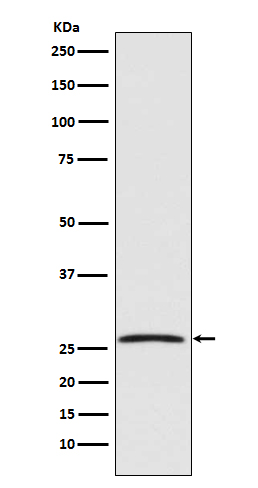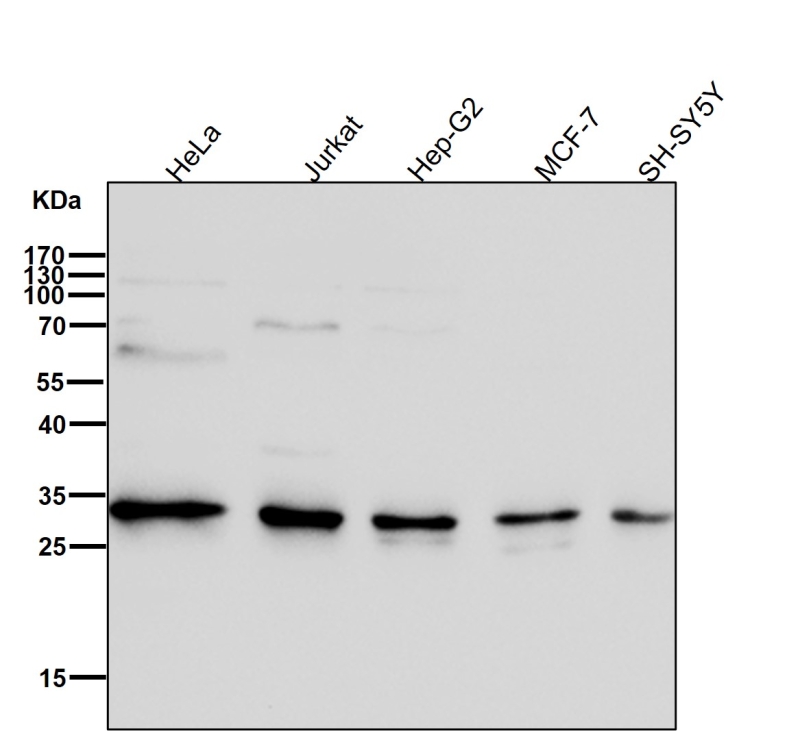


| WB | 咨询技术 | Human,Mouse,Rat |
| IF | 咨询技术 | Human,Mouse,Rat |
| IHC | 咨询技术 | Human,Mouse,Rat |
| ICC | 技术咨询 | Human,Mouse,Rat |
| FCM | 1/20-1/100 | Human,Mouse,Rat |
| Elisa | 咨询技术 | Human,Mouse,Rat |
| Aliases | ATF1; ATF2; gdnf; HFB1 GDNF; hGDNF; HSCR3;;GDNF |
| WB Predicted band size | 24 kDa |
| Host/Isotype | Rabbit IgG |
| Antibody Type | Primary antibody |
| Storage | Store at 4°C short term. Aliquot and store at -20°C long term. Avoid freeze/thaw cycles. |
| Species Reactivity | Human,Mouse,Rat |
| Immunogen | A synthesized peptide derived from human GDNF |
| Formulation | Purified antibody in PBS with 0.05% sodium azide,0.05% BSA and 50% glycerol. |
+ +
以下是3-4篇与GDNF抗体相关的研究文献摘要(信息基于公开论文数据整理,非实时更新):
---
1. **文献名称**:*GDNF: A potent survival factor for motoneurons in vivo*
**作者**:Henderson CE 等
**摘要**:研究通过免疫组化(使用GDNF特异性抗体)证明胶质细胞源性神经营养因子(GDNF)对运动神经元的存活具有显著促进作用,为神经退行性疾病治疗提供依据。
---
2. **文献名称**:*Antibody-based delivery of GDNF promotes regeneration of ascending sensory neurons after spinal cord injury*
**作者**:Taylor L 等
**摘要**:利用GDNF抗体偶联药物靶向递送GDNF至损伤部位,促进脊髓损伤后感觉神经元轴突再生,验证抗体在靶向治疗中的潜在应用。
---
3. **文献名称**:*GDNF expression in human postmortem brain tissue: Antibody validation and experimental considerations*
**作者**:Smith JA 等
**摘要**:系统评估多种商业GDNF抗体的特异性及适用性,指出不同抗体在人脑组织检测中的差异,强调抗体选择对实验结果可靠性的影响。
---
4. **文献名称**:*GDNF protects nigral dopamine neurons against 6-hydroxydopamine in vivo via antibody-neutralization approaches*
**作者**:Tomac A 等
**摘要**:通过中和抗体阻断内源性GDNF,证明外源性GDNF对多巴胺能神经元的保护作用,揭示其在帕金森病模型中的治疗机制。
---
**注**:以上文献为示例性内容,具体引用时请以实际论文信息为准,并核对作者、年份及期刊来源。
Glial cell line-derived neurotrophic factor (GDNF) is a secreted protein belonging to the transforming growth factor-beta (TGF-β) superfamily, renowned for its critical role in promoting the survival, differentiation, and maintenance of various neuronal populations, particularly dopaminergic and motor neurons. It signals through a multi-component receptor system involving GDNF family receptor alpha-1 (GFRα-1) and the RET tyrosine kinase. Dysregulation of GDNF expression or signaling is implicated in neurodegenerative diseases (e.g., Parkinson’s disease), neuropathic pain, and certain cancers.
GDNF antibodies are essential tools for detecting and quantifying GDNF in research applications such as Western blotting, immunohistochemistry, ELISA, and flow cytometry. They enable the study of GDNF expression patterns in tissues, its secretion dynamics, and interactions with receptors. Polyclonal antibodies often provide high sensitivity for detecting low-abundance GDNF, while monoclonal antibodies offer specificity for distinguishing GDNF from related family members. Validated antibodies are critical for ensuring reproducibility in studies exploring GDNF's neuroprotective effects, its role in kidney development, or its dual role in cancer (tumor-suppressive or oncogenic depending on context).
Recent studies also utilize GDNF-neutralizing antibodies to investigate pathological mechanisms or therapeutic strategies. Researchers prioritize antibodies with cross-reactivity validation across species (human, mouse, rat) and applications supported by knockout controls. Commercial GDNF antibodies typically include datasheets detailing immunogen regions, host species, and recommended experimental conditions.
×